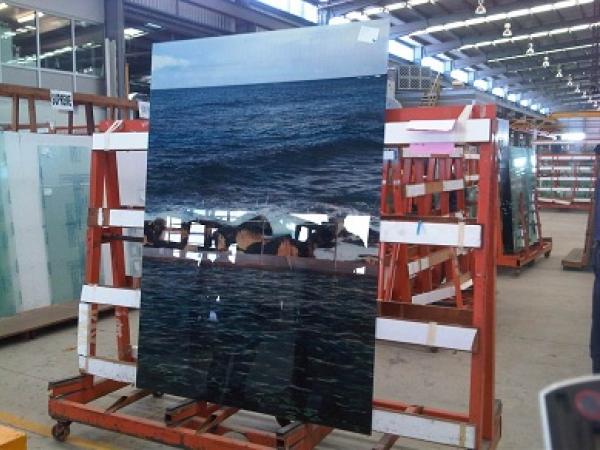The ancient Romans and Egyptians created decorative but functional objects such as cups and vases from glass. Cathedrals have used stained glass windows for both light and decoration for more than a millennium. A somewhat more modern innovation is digital ceramic printing directly onto glass – and G.James are pleased to be able to offer this new medium.
What sort of applications I can use printed glass in?
- Balustrading – Yes. Printed glass would be suitable in this application as standard furnaced PVB (Polyvinyl butyral) laminate if edges are protected, printing to surface #2 (the inner/interior surface) or with an SGP (SentryGlas®Plus) interlayer with unprotected edges, printing to surface #2.
- Windows - Yes, with ceramic printing to the inside or in a laminate as above.
- Awnings - Yes. A heat strengthened laminate with PVB and SGP is recommended. Monolithic printed glass is not suitable for this application.
- Splashbacks - Yes, when combined with two-pack paint backing to obscure the wall behind.
- Office Partitions – Yes, as a furnaced laminate only.
- Reception areas/Feature walls - Yes. Care should be taken to co-ordinate the colour of the backing wall with the image and its density – a light image would require a neutral tone wall to stop any showthrough.
- Pool Windows – Yes, as a furnaced laminate printed to surface #2.
- Signage - Suitability of printed glass for this application would depend on the colours required. Laminate would be required for external applications, internal applications could use monolithic glass.
- Building Façades – Yes. Printed glass can be incorporated into an IGU and coated if necessary.
.jpg)
What does the printing process involve?
Digital images are run through a specialist software program that separates the image into colour layers available on the Colourlite Image system. The ink used has special ceramic pigments which give it its colour – these inks are lead and cadmium free. The Glassjet printer is a large flatbed printing set up.
Printing on the Glass
Toughening the printed Glass
Once the image has been printed, the ink is touch dry, the glass is then furnaced at a minimum of 600 degrees Celsius to cure and bond the ceramic ink to the glass. Furnacing brings out & sets the colour of the printed image. The time to complete the process is dependent on the thickness of glass necessary to cure the ceramic.
Glass samples

Click to enlarge. - Ceramic Painted Glass Samples
What are the image requirements for a digital image?
The highest possible resolution/quality image should be supplied to achieve satisfactory results. A 2mb image should provide acceptable quality at the minimum glass print size of 200mmx300mm. Exact requirements will vary based on the source image, as well as the intended use for the glass panel.
Most common image formats can be accepted, though jpg or tiff formats are preferred. Images up to 10mb in size can be accepted by email, for larger files physical storage formats can be accepted (cd, dvd, usb stick, etc.) or a link to a file location in an online repository. We do offer limited photo preparation services, this can be quoted on a project by project basis. Text may be included in images at no extra cost, and should be embedded in the file as an outlined font in eps format.
What are the limitations of the process?
Unfortunately due to the nature of the inks used (in particular, the lack of substitutions for the toxic cadmium), bright reds are unachievable, as well as pinks. Cyan is another colour that is unable to be reproduced properly. Thus the inks used do not offer a ‘full colour’ range, however the specialist software used will process input images to achieve the closest possible colour match. Printing is size limited to a maximum of 3700x2200mm per panel.
How does the ordering process work?
Contact the sales staff at G.James Glass Sales with your requirements, and they will be happy to assist. G.James branches are able to provide a full measurement service, which will also include an assessment of fit for purpose & duty of care requirements. Digital images are printed locally at our Brisbane facility, whilst monochrome graphics can also be produced at our Sydney and Melbourne facilities. G.James offers a full delivery service for our products, to both domestic and commercial sites. Our branches are also able to fully install the product.
.jpg)
How do I look after my printed glass once I’ve got it?
Any regular glass cleaning product may be used on ceramic printed glass – even something as simple as water with methylated spirits, applied with a soft cloth. The ceramic printing is resistant to cleaning products as it is bonded to the glass during the heating process. Products that are capable of damaging glass will also affect the ceramic print. The ceramic inks are resistant to fading, and are covered by a 10 year warranty.
Printed Glass Fixings Example


Printed Glass Example

About G.James
G.James' Vision is to develop a highly sustainable and independent Glass & Aluminium Company.
From 1917 to today, G.James Glass & Aluminium continues to be involved in the manufacture, fabrication, processing and installation of a diverse range of products and is Australia’s leading integrated Glass & Aluminium manufacturer and contractor.
G.James is a private family owned group of companies operating from over 32 different sites and with more than 2000 employees.
2012 welcomes G.James Glass & Aluminium into their 95th year of operation and industry experience.




















